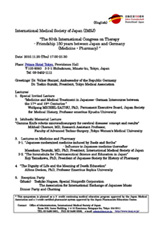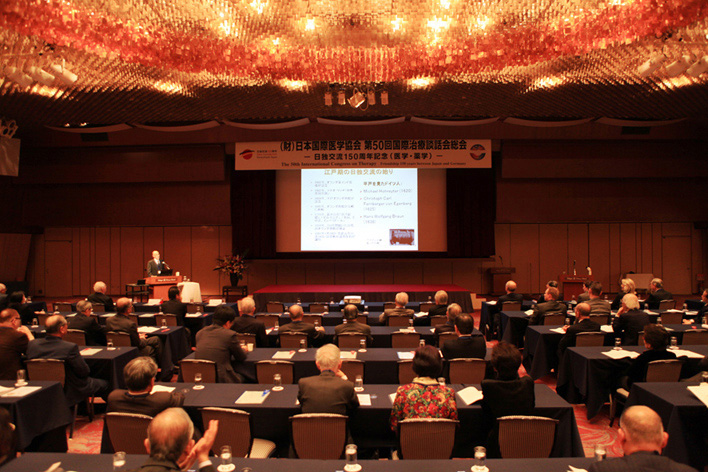Medicine and Medical Treatment in Japanese- German Intercourse between the 17th and 19th Centuries |
Medicine and Medical Treatment in Japanese–German Intercourse between the 17th and 19th Centuries
In 1927, after having travelled through China and Japan, the renowned German physiologist Ludwig Aschoff emphatically declared that there was no need for any kind of Western “medical mission” in Japan. This outstanding success owed much to Japan’s modernization efforts during the second half of the 19th century, but its roots go back to the 17th century, when the relocation of the Dutch trading post from Hirado to Nagasaki and the permanent presence of physicians led to a gradually intensifying exchange of medical knowledge, books, instruments and pharmaceuticals.
Until 150 years ago German–Japanese intercourse did not have any diplomatic background. It was predominantly of a cultural nature and embedded in the framework of Dutch–Japanese trade. World maps and occasional writings such as the “Notes on Western Countries” (1715) by Arai Hakuseki conveyed the existence of ‘Zerumania’, but this was of no importance in actual encounters, as every European setting foot on Japanese soil officially had to be a ‘Redhead’ (kōmōjin) from ‘Oranda’. Nevertheless, a number of German merchants, pharmacists, physicians and other specialists made significant contributions to mutual understanding between Japan and Europe. German books in Dutch translation as well as occasional ‘exotic rarities’ also provided another perspective on man and nature.
For most of the Edo period, the Japanese response to European stimuli focused on medicine and allied sciences. It began in 1650 with a German surgeon, Caspar Schamberger, who is credited with the birth of ‘Caspar-style surgery’ (kasuparu-ryū geka). His successors at the trading post on Dejima continued to pass on medical knowledge, which gradually merged with other disciplines to form ‘Dutch studies’ (rangaku), as 18th century Japanese scholars called it.
As is always the case, events were influenced by a variety of factors: Schamberger’s professional education and experience, his mastery of etiquette at the court at Edo, a prolonged stay in Edo of his superiors due to the illness of Shôgun Ietsuna, and the strong interest of grateful high-ranking patients. Seventeenth century Western medicine entered Japan from the top of her society, spreading from Edo, and to a lesser degree from Nagasaki, into the regions. Only two decades after Schamberger left Japan, a license from the Dutch trading post surgeon boosted careers in feudal domains and at the court. But the continued success of ‘redhead-style medicine’ was not merely the result of its medical and social usefulness. Japanese physicians were less subject to the prevailing rigid social restrictions, and thus were in a better position than most of their countrymen to travel, to seek and to spread new knowledge.
Western medicine, with its new recipes and expensive drugs, inevitably led to the search for local substitutes, thus stimulating Japanese botanical studies and the import of seeds and live plants. Here again Germans entered centre stage. In response to Japanese requests Godefried/Gottfried Haeck and Franz Braun from Andreas Cleyer’s pharmacy in Batavia successfully taught distillation techniques at Dejima and conducted botanical surveys in the Nagasaki area, thus promoting a more independent view on Chinese botany and materia medica.
On the other hand Engelbert Kaempfer (1651–1716), second only to Siebold as the most prominent German in early modern Euro–Japanese intercourse, did not exert much influence on Japanese medicine. First and foremost he deserves credit for his pioneering research on Japan. Europe is indebted to him for the most detailed description of acupuncture and moxibustion at the time including Japanese medical concepts, instruments, and source materials that were not known in China. Kaempfer’s writings dominated the 18th century.
Like Kaempfer, Philipp Franz von Siebold (1796–1866) was a trained physician and ambitious naturalist. He was also the last Western researcher striving for a comprehensive description of Japan. Today he is praised for having brought modern medicine to the country, but his treatment methods do not differ significantly from those of his predecessors. He was more influential in his ways of collecting objects and information, and of comparing and analyzing. It is this combination of medicine and natural science that paved the way for modern medical education introduced by Pompe van Meerdervort two decades later and further expanded and institutionalized by the Meiji pioneers B. C. Müller and Th. E. Hoffmann.


